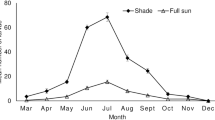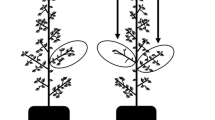Abstract
White clover growing in New Zealand is experiencing increasing levels of ultraviolet-B (UV-B) radiation as a result of ozone depletion. We evaluated the effects of UV-B radiation on the foliar chemistry of two populations of white clover (Trifolium repens L.), ’Huia’ and ’Tienshan,’ and the consequences for the performance of armyworms (Spodoptera litura) and cutworms (Graphania mutans). Plants were grown in controlled environment rooms with and without supplemental UV-B radiation at a dose of 13.3 kJ m–2 day–1, corresponding to a 25% mid-summer ozone depletion above Palmerston North, New Zealand. In both white clover populations, UV-B radiation elicited changes in foliar chemistry, including slight increases in nitrogen concentrations and decreases in carbohydrate concentrations. In addition, the ’Huia’ population showed decreases in fiber concentrations and marked increases in cyanogenic activity. No change in UV-absorbing compounds was detected in either population. Long- and short-term feeding trials were conducted to assess dietary effects on insect growth, consumption, and food utilization. Changes in the performance of both insect species were generally small. The most pronounced effect was a 36% reduction in weight of S. litura after 2 weeks of feeding on Huia grown at high UV, but larval development times were only slightly prolonged and pupal weights were unaffected. S. litura short-term performance was affected by differences in white clover population. The long-term performance of G. mutans was not affected and its short-term performance (stadium duration and consumption rate) was only marginally affected by the high-UV treatment. We conclude that the effects of elevated UV-B radiation on white clover plant chemistry can be specific to certain plant populations. The differences in sensitivity of the two generalist insect species suggest that effects may also be specific to certain plant-herbivore associations. These results indicate that future UV-B herbivory studies should examine genotypic effects in both plants and animals.
Similar content being viewed by others
Author information
Authors and Affiliations
Additional information
Received: 18 May 1999 / Accepted: 25 July 1999
Rights and permissions
About this article
Cite this article
Lindroth, R., Hofman, R., Campbell, B. et al. Population differences in Trifolium repens L. response to ultraviolet-B radiation: foliar chemistry and consequences for two lepidopteran herbivores. Oecologia 122, 20–28 (2000). https://doi.org/10.1007/PL00008831
Issue Date:
DOI: https://doi.org/10.1007/PL00008831




